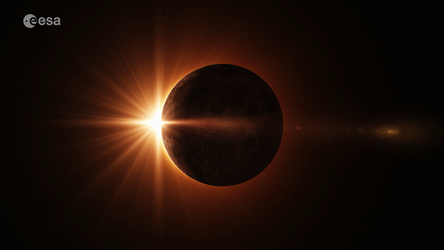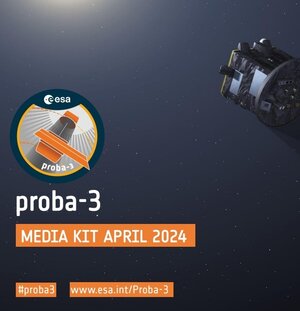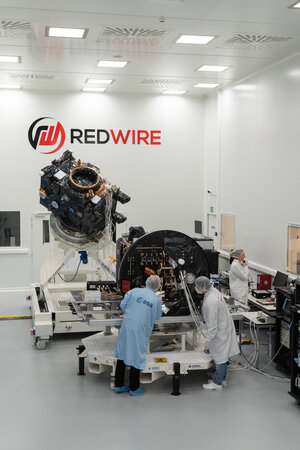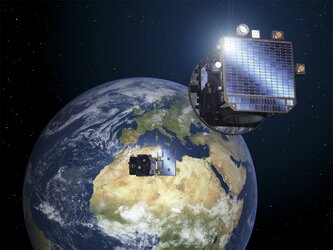Proba-3 tries formation flying on the ground
The two Proba-3 satellites were set facing each other across a cleanroom as cameras, LEDs, a laser and shadow sensors were activated in turn, testing the systems that will let the pair sense their precise positions relative to each other, allowing them to line up precisely in orbit down to a single millimetre.

When two satellites venture to within a few hundred metres of each other, the usual response is a collision avoidance manoeuvre. But ESA’s double-satellite Proba-3 will be performing a kind of controlled dance in orbit, its two elements coming as close as 25 m apart.
Lining up with the Sun
Around 150 m from each other, the pair will line up with the Sun to cast a shadow from one satellite to the other, creating prolonged artificial solar eclipses to reveal the faint outer atmosphere of the Sun without being blinded by its brightness.
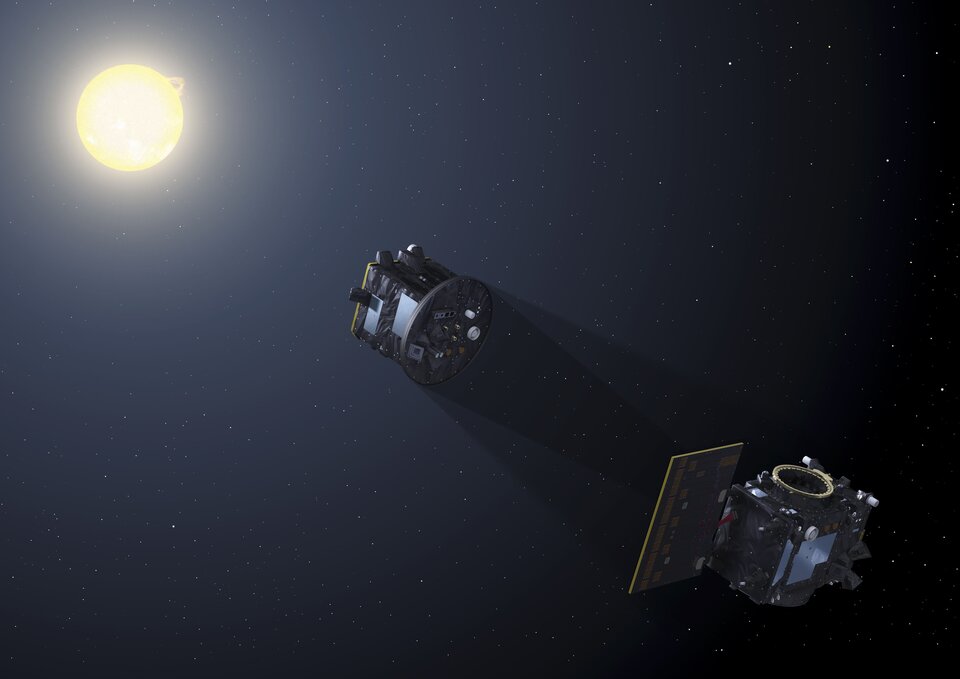
How will this be possible? Like autonomous cars on Earth, the Proba-3 satellites make use of multiple sensors using different technologies to derive their positions relative to each other.
All of these systems have to work perfectly for the mission to succeed – so they were tested together with the spacecraft software for the first time in the cleanroom of Redwire in Kruibeke near Antwerp in Belgium.


Access the video
“Proba-3 is a formation flying demonstration mission, and these systems really form the mission’s core,” explains ESA software and systems engineer Teodor Bozhanov.
“To maintain the position of the two satellites to the necessary precision we need to have performed specific steps in sequence, one after the other. Starting from optical observations we move to laser metrology then finally detection of the shadow being cast from one satellite to the other. If one of these steps is not a success then we cannot move on the next.”

Satellites face to face
The two Proba-3 platforms were placed a little over 15 m away from each other – the maximum distance available within the confined setting of the Redwire cleanroom – although in space the pair will be flying around ten times further apart when the mission’s formation flying systems come into use.
Personnel from Proba-3 prime contractor Sener in Spain joined the Redwire and ESA teams for the week-long test campaign, along with experts from Danish space research institute DTU Space, which manufactured Proba-3’s Vision Based Sensor system.

Radio, satnav and stellar navigating
The pair will be connected throughout their orbit using a radio-based inter-satellite link system from Tekever in Portugal, continuously updating their range from each other.
They will also chart their absolute positions in space using specially designed satellite navigation receivers, which need to take account of the fact that Proba-3’s highly elliptical 60 000 km altitude orbit will pass right through the orbits of satnav constellations and high up into space.
Finally the pair are additionally equipped with star trackers – computer-linked cameras that recognise the constellations around them to reveal each satellite’s ‘attitude’, or current pointing direction in space.

LEDs, cameras, laser – getting into position
It is once the satellites come closer than about 250 m from each other that the relative navigation systems used for precise formation flying come into play – trialled one after the other during this test campaign.
The first step is the Vision Based Sensor system. A wide-angle camera is used to track an LED pattern on the other satellite, providing relatively coarse information on the satellites’ distance from each other, as well as supplementary information on their attitude.
This is supplemented by a narrow-angle camera which locks onto a second, much smaller LED pattern, providing relative positioning information down to a scale of about a single centimetre.

Millimetre accuracy achieved
Next in sequence, the Fine Lateral and Longitudinal Sensor on Proba-3’s ‘Occulter’ spacecraft shines a laser towards a corner cube retro-reflector on the face of the ‘Coronagraph’ spacecraft, which is reflected back in turn to the Occulter. This FLLS provides relative positioning down to millimetre accuracy.
The final positioning technology is the Shadow Positioning Sensor system, based on photo detectors arranged around the lens that Proba-3’s main coronagraph instrument will use to monitor the Sun’s surrounding corona.

If the approximately 5-cm diameter shadow is cast correctly, centred onto the Coronagraph, then it should be equal in illumination on all sides; any discrepancy would trigger a correction.
First time combined testing
“All these systems have been tested before at unit level and in simulations,” comments ESA guidance, navigation and control engineer Jonathan Grzymisch. “But this was really the first time that all our hardware and software was operated together, as it will operate in space. The navigation system was processing actual hardware inputs, in sequence from coarser measurements to finer and finer metrology.

“The constrained size we were working with led to a complex test setup, because basically we are tricking the guidance, navigation and control software to work outside of its operational domain. For instance we used a robot from our Guidance, Navigation and Control Lab at ESTEC in the Netherlands to hold a laser retroreflector, because the test layout didn’t permit alignment with the real one on the Coronagraph satellite.
“In the event however, the testing went quite smoothly, bringing us a step nearer to launch readiness. The next time all these systems run together will be in space, after the mission begins.”
Proba-3 is scheduled to launch this autumn on an Indian PSLV-XL launcher.







